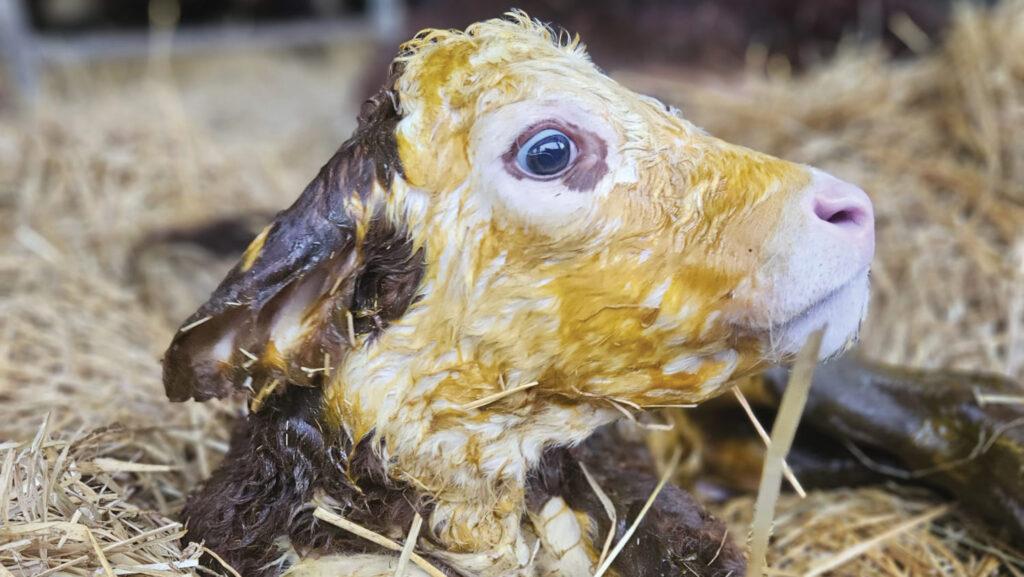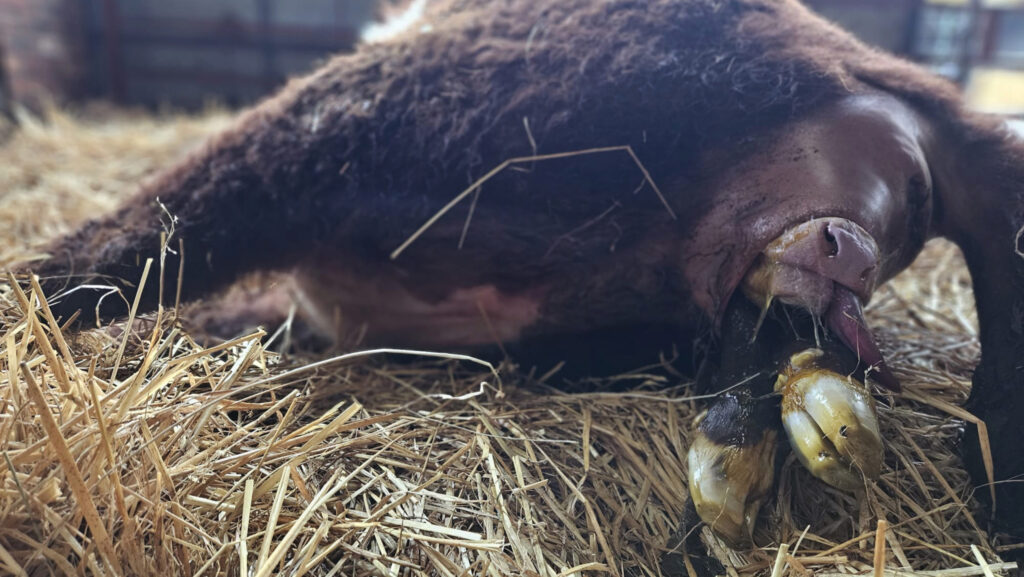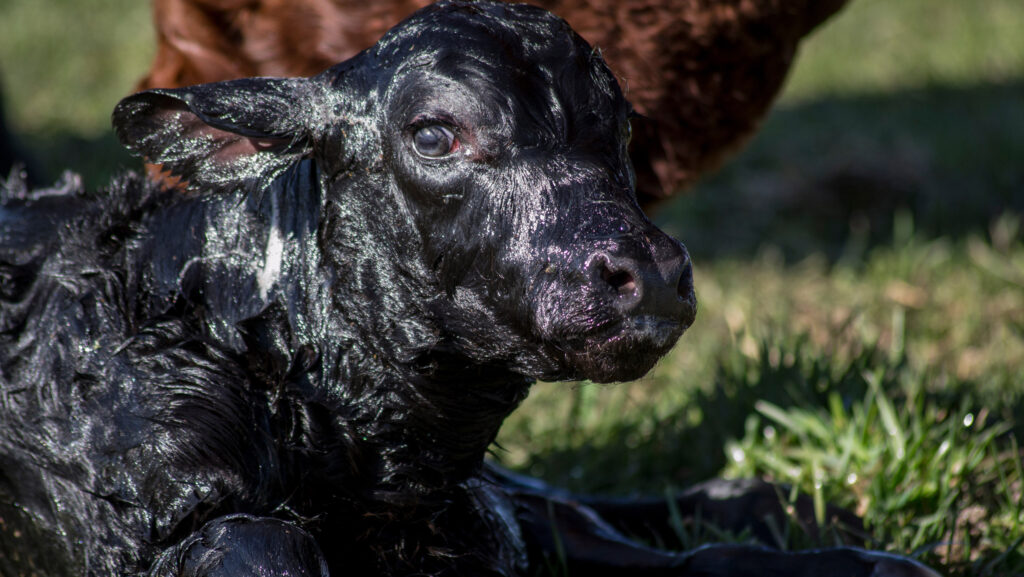5 ways to ensure a safe and successful beef calving
 © Romany Herefords
© Romany Herefords Understanding basic principles of animal behaviour and physiology can help farmers develop a functional and safe calving system.
Rarely a year goes by without Health and Safety Executive records showing a farmer or farm employee being killed by a beef cow at calving.
Farmers Weekly asks animal behaviour expert and welfare consultant Miriam Parker, of Livestockwise, and veterinary investigation officer Alwyn Jones, of Scotland’s Rural College, for advice.
See also: How to manage less common farm health and safety risks
1. Understand the cow
Cattle behaviour is driven by instinct, so any calving needs to be approached with care and caution, irrespective of her normal demeanour.
Miriam lists some key behaviour traits that can help farmers understand calving cows.
Prey animal
- Background As a mammalian herbivore (prey animal), a pregnant cow will naturally want to find a safe and quiet calving place.
- Action Use calving calendars to help time the movement of cows to calving pens or designated fields well ahead of calving. Work in the United States concluded that moving cows while the first water sac was being expelled delayed the start of contractions. Manage or design “favourite” corners in the shed or places in the field by, for example, hanging additional gates, using big bales in key spots or erecting additional fencing, where cattle can be handled safely in situ.
Parental investment
- Background A cow typically has one calf after a 283-day gestation. By comparison, sheep give birth, often to twins, after a 152-day gestation. This may explain why cows have a relatively high “parental investment” and can be very protective, irrespective of breed and management system. This is amplified by hormones such as cortisol, which are elevated before, during and after calving, making a cow edgier than normal.
- Action Never enter a confined space with a cow that is calving without ensuring you have an exit strategy. Can you get over, under, behind or through a gate or feed barrier? Approach from the side where the cow can see you, and ensure you move slowly. Your instinct is to go to the rear end, but you will surprise or startle her coming from behind. Talk quietly to indicate your presence before you appear. Step back if you see signs of anxiety or a tail swish. Do not turn your back on her.
Dog threat
- Background A cow is very likely to see a dog as a clear threat, rather like a wolf or a fox. Farm dogs or walkers in fields with a dog, or several dogs – which could look like a pack – are likely to trigger natural protective behaviours.
- Action Keep dogs out of sheds, fields and pens where cattle are calving or have recently calved.
Protection of calf
- Background A calf will instinctively lie down out of sight for much of its early life. This is how it would avoid being seen by predators in the wild. Cows will hide calves individually for the first five days or so (like deer), then start to create creches. Only at seven to nine weeks will a calf start to follow its mother around for long periods.
- Action Guidelines are for 20 minutes of suckling in the first two hours of the calf’s life, but do not be concerned to see a calf lying down. If approaching a lying calf, keep your eyes on the cattle and be ready to retreat quickly to a safe place if the dam makes her presence felt. Calving cameras make it easier to observe from a distance. See the video below of a narrow miss on a North Yorkshire farm when a cow moved in to protect its calf while farmworkers got to work.
2. Understand safety principles
Whether she is a 450kg Jersey-cross or a 900kg continental, a calving cow is 5-10 times heavier than a stockperson.
“As stockpeople, our instinct to help the cow and calf often means we don’t think of our own safety first,” says Miriam. “Make it a habit to stop, look, think – and then act.”
Thought processes and reactions can be flawed and slow during calving, particularly if calving a cow at 3am or after several weeks of lambing. Lone working and age (over 65) are also common factors with cattle-related fatalities.
The Health and Safety Executive recommends using the “hierarchy of controls” to reduce the risks around calving:
- Can the hazard be eliminated?
- Cull dangerous cows
- Have a zero-tolerance policy of bad-tempered cows
- Towards the end of the farmer’s career, consider whether it is time to sell the cows
- Can the hazard be substituted?
- Proactively select those animals that you can work with
- Can you use a breed that is more docile?
- Can behaviour be recorded at calving to influence breeding decisions?
- Avoid placing calving cows where they might become a risk to others.
Engineering controls
- Calving pens should be fitted with calving gates to protect people. These should feature space for the cow’s head to fall to the floor if required, and a quick-release latch. Designs and prices vary hugely but the Farming Equipment and Technology Fund (FETF65) 2024 offers £295 towards a gate that may cost £700-£1,000
- Is there an easy escape route for people?
- If outdoors, a vehicle or vehicles can be used as barriers. Make sure they are going to do the job (a quadbike may not be sufficient)
- Specialist equipment such as a calf catchers (about £1,500) may be worth the investment.
Admin and personal protective equipment controls
- Try not to work alone. for lone workers, always use a barrier, and let someone know where they are. Carry a mobile with you
- Use of CCTV can help by monitoring people remotely
- Personal protective equipment will give only limited protection – a barrier and a safe escape route are best.

© Romany Herefords
3. Understand a natural calving
Stage one: Before calving
- What happens The cow starts to separate herself from the herd, looking for a safe and quiet place to calve. Her cervix becomes dilated.
- What to look for Restless behaviour: she may swish her tail and kick her belly. She will likely pass mucous from the vagina and rupture her first water bag, a reddish, blood-filled sac.
- How long it takes In mature cows, this can take three to six hours; in heifers, it can take 24 hours.
Stage two: Contractions
- What happens Stage two starts at the onset of contractions. The cow typically pushes until the calf is born.
- What to look for The second water sac (blue-grey in colour), which holds fluid around the calf, is ruptured and appears at the vulva. The calf’s head and two front legs show (anterior position) and the calf slides out.
- How long it takes This can take just 5min but may take 30min to four hours.
Stage three: Post-calving
- What happens The foetal membranes are passed, signifying the end of the process.
- What to look for A transparent and white sinewy sac containing dozens of red discs, which typically follows the calf.
- How long it takes This is usually expelled after two to three hours but can take 12 hours or more following a difficult calving.

© Adobe Stock
4. Understand when to help
Alwyn Jones suggests the following checks during the early stages of calving, if the farmer or stockperson is on hand to monitor progress.
- Water sac Investigate if the water sac has been showing for two hours and no progress has been made.
- Straining Investigate after 30min of hard straining with no progress.
- Gliding Each contraction should lead the calf to glide in and out. If this does not happen, there may be a blockage, or the calf may be too big.
When intervening, be guided by the cow and take time. Calving is a slow process.
- Be clean It may help to tie or restrain the tail if possible. Wash hands and arms before putting on disposable rectal gloves. The cow needs to be cleaned to avoid manure or bedding/dirt contaminating the reproductive tract. Hands, arms and gloves need cleaning and lubricating, as does the vagina. Lubricant is cheap, makes life easier for you and minimises trauma to the vagina and cervix.
- First check A hand should pass easily through the cervix if it is fully dilated. If the cervix is still closed, a caesarean may be required.
- Room near the head If the cervix is dilated but the calf is not coming, check the head and legs. If a hand will not fit above the head in the pelvic canal, then the calf could be too big.
- Is the calf alive? If you fear the worst, gently pinching between the hooves or touching the tongue or eyelids and feeling for movements will confirm whether the calf is alive.
- Front or back legs? Fetlocks should be able to be pulled outside the vulva and the legs should be straight. If the legs are crossed over, it could be a sign of a large calf with big shoulders, and a vet may be needed. Front leg joints bend in the same direction, whereas rear leg joints bend in opposite directions. This can help orientate the calf.
- Careful pressure If you use a calving jack, apply pressure only when the cow is pushing. The jack applies two to three times more pressure than two people pulling hard, so use that power wisely.
- Rule of three A calf can be pulled if there are two front legs and a head or two hind legs and a tail.
- Avoid trapping Once the hips are out, make sure the rest of the calf follows quickly, as the umbilical cord can get compressed between the calf and the cow’s pelvic floor. If the backside of the calf is stuck, twisting 45deg can help.
- Pain relief After calving, if a cow has struggled, pain relief and a non-steroidal anti-inflammatory are advised.
- Check for blood If there is a lot of bleeding from the uterus, check for a tear and consult a vet.
5. Understand your input
As well as managing body condition score, breeding for calving ease and short gestation, and avoiding tight pelvises, there are other management decisions that can help with calving:
- Planning Stocking up before calving on rectal gloves, lubricant, clean calving ropes, needles/syringes, colostrum tubes and frozen or replacement colostrum. Chlorhexidine or iodine-based disinfectants are good for cleaning arms and adding to water to clean around the vulva.
- Handling Behaving quietly and calmly around your cattle through the year will be rewarded at calving.
- Nutrition Supplying 30g/day of a high-magnesium mineral (in a lick or top dressed) in the last two weeks of gestation can help muscle tone and calving.
- Feeding Routinely feeding forage to cows later in the evening (as late as 10pm) has minimised night-time calvings in trials and on working farms.
